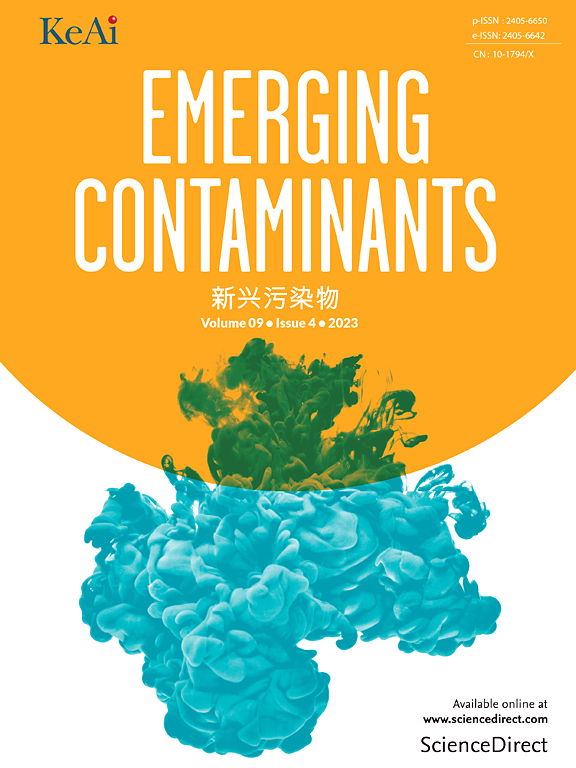海南西部近海海域抗生素耐药基因分布、发生及微生物多样性的季节性研究
IF 6.9
2区 环境科学与生态学
Q1 ENVIRONMENTAL SCIENCES
引用次数: 0
摘要
抗生素耐药基因(ARGs)已成为世界范围内人类健康的威胁之一。本研究采用SmartChip实时荧光定量PCR和qPCR对海南西部24个采样点的ARGs和移动遗传元件(MGEs)进行定量分析。利用16S rRNA高通量测序分析微生物群落结构。通过分析ARGs与环境因子、MGEs和微生物多样性之间的相关性,阐明旱季和雨季ARGs的分布、可能来源和潜在宿主。结果表明,干、雨季在海南西部近岸海域共发现ARG类122种,检出率为93.85%,MGE类13种,检出率为100%。旱季ARGs和MGEs的绝对丰度高于雨季。其中,氨基糖苷类抗性基因在旱季的绝对丰度最高,其次是MLSB抗性基因,而肽抗性基因的绝对丰度最低。在雨季,氨基糖苷类抗性基因的绝对丰度最高,其次是磺胺类抗性基因,而肽类抗性基因的绝对丰度最低。ARGs与MGEs呈显著相关,表明MGEs可能介导ARGs的水平转移和扩散。环境因子分析表明,温度、溶解氧和总磷是影响ARGs空间分布的主要因素。在门水平上,变形菌门、放线菌门和拟杆菌门是旱季和雨季的核心微生物。本文章由计算机程序翻译,如有差异,请以英文原文为准。
Distribution and occurrence of antibiotic resistance genes and microbial diversity in western Hainan's inshore seawaters: A seasonal study
Antibiotic resistance genes (ARGs) have become one of the threats to human health worldwide. In this study, SmartChip real-time fluorescent quantitative PCR and qPCR was employed to quantify the ARGs and mobile genetic elements (MGEs) at 24 sampling sites of western Hainan. High-throughput sequencing of 16S rRNA was utilized to analyze the structure of microbial communities. The correlation among ARGs, environmental factors, MGEs, and microbial diversity was analyzed to elucidate the distribution, possible sources, and potential hosts of ARGs during the dry and rainy seasons. The results showed that 122 ARG species with a 93.85 % detection rate and 13 MGE species with a 100 % detection in the inshore waters of western Hainan during the dry and rainy seasons. The absolute abundance of ARGs and MGEs was higher during the dry seasons compared to the rainy seasons. Among these, aminoglycoside resistance genes exhibited the highest absolute abundance during the dry season, followed by MLSB resistance genes, while peptide resistance genes demonstrated the lowest abundance. During the rainy season, the absolute abundance of aminoglycoside resistance genes is the highest, followed by sulfonamides resistance genes, while peptide resistance genes remain the least abundant. ARGs were significantly correlated with MGEs, suggesting that MGEs may mediate the horizontal transfer and spread of ARGs. Environmental factor analyses showed that Temperature, dissolved oxygen, and total phosphorus play a key role in affecting the spatial distribution of ARGs. At the phylum level, Proteobacteria, Actinobacteria, and Bacteroidetes are the core microorganisms during the dry and rainy seasons.
求助全文
通过发布文献求助,成功后即可免费获取论文全文。
去求助
来源期刊

Emerging Contaminants
Medicine-Public Health, Environmental and Occupational Health
CiteScore
10.00
自引率
6.70%
发文量
35
审稿时长
44 days
期刊介绍:
Emerging Contaminants is an outlet for world-leading research addressing problems associated with environmental contamination caused by emerging contaminants and their solutions. Emerging contaminants are defined as chemicals that are not currently (or have been only recently) regulated and about which there exist concerns regarding their impact on human or ecological health. Examples of emerging contaminants include disinfection by-products, pharmaceutical and personal care products, persistent organic chemicals, and mercury etc. as well as their degradation products. We encourage papers addressing science that facilitates greater understanding of the nature, extent, and impacts of the presence of emerging contaminants in the environment; technology that exploits original principles to reduce and control their environmental presence; as well as the development, implementation and efficacy of national and international policies to protect human health and the environment from emerging contaminants.
 求助内容:
求助内容: 应助结果提醒方式:
应助结果提醒方式:


